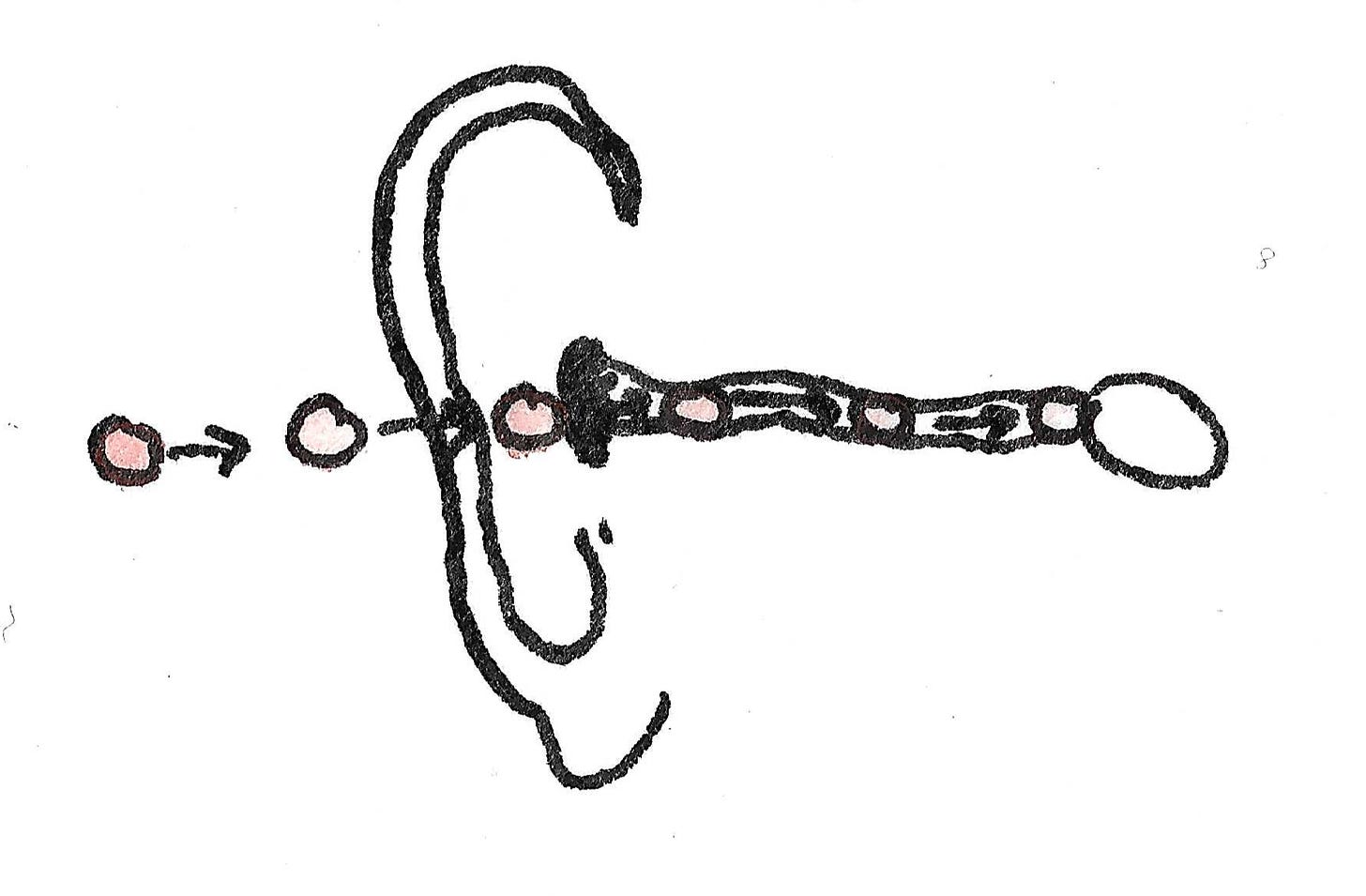We’ve talked about sight, so let’s turn to the next human sense: hearing.
The thing about hearing is that it’s a chain reaction, even more so than sight is. You see (ha), when we see something, there’s tiny particles of light bouncing off of things and going into our eyes. As small and unsubstantial as photons are, they are entities that exist and can travel and remain more or less themselves in the process.
Hearing is a different story. There is no sound particle that makes its way through our ears and into our brain. Instead, there’s just air moving in a very specific way that sets off a series of reactions that make my head spin a little bit. So let’s try to take this step by step.
Imagine you’re an air molecule, living your best air molecule life in the company of many, many other air molecules. You’re always moving a bit, because everything in the universe is always moving a little bit unless it’s at absolute zero.
Suddenly, something happens — a book falls to the ground, for example. Unfortunately for you, this book happens to fall straight onto you and your friends. There isn’t room for both the book and air molecules in that precise spot, so paf! All the air molecules, you included, get pushed aside to make way for the book.
Now you’re all moving rather fast. And because the air around you is full of — you guessed it — other air molecules, you start bumping into them and making them move faster. So you watch as a sort of wave of bumping molecules passes through the air around you. After an initial period of interest, your attention focuses on something else, you go back to vibrating at your normal rate, and you forget all about the sound wave you and your friends caused.
But some of the air molecules further down the chain reaction have hit something: an ear. And because the ear has lots of room in it for some vibrating air molecules, the sound wave continues down the ear canal until it hits the ear drum.
The ear drum, feeling all the air molecules vibrating, follows suit. In so doing, a trio of small bones called the malleus, the incus, and the stapes are also made to vibrate, because when in Rome, do as the Romans do.
The stapes, in turn, is connected to a structure named, very originally, the oval window. Just as originally, the oval window starts to vibrate, but here we get to something different. You see, the oval window is attached to the cochlea, which looks like a snail shell and is full of fluid. So when the oval window starts to vibrate, the fluid also starts to vibrate, except that a fluid vibrating just looks like a fluid moving, which is precisely what it is.
So the fluid moves back and forth within the cochlea, eventually hitting the equally originally named circular window. The reason the fluid hits the circular window instead of the oval window is the organ of Corti, which divides the cochlea in two and keeps the fluid moving in the right direction.
But! This is not the sole purpose of the organ of Corti. It is also home to a number of little hair cells, who must be rather confused at finding themselves in the inner ear, rather than on a face or a leg. Because the organ of Corti is right in the middle of all this moving liquid, the organ is constantly caressed by the swaying fluid. Being, like everything else in the ear, flexible, the pressure of the fluid presses down on it, which causes the hair cells to also start to vibrate.
Now, the hair cells themselves have multiple parts, the most important one for our purposes being the hair bundle. The hair bundle is an ensemble of little filaments, all tied together by a sort of spring-like structure. Said spring-like structure is attached to them by a little potassium channel.
This potassium channel is meant to regulate the amount of potassium in a given place. So when the hair cells start to vibrate, the springs get pulled a bit, and essentially yank the gate open.
“Excellent,” think the bits of potassium that are floating around in the fluid, “let’s go in.”
And because biology really is just a series of chain reactions, as soon as the hair cells get filled with potassium, calcium channels open up, and bam! calcium joins the party.
The appearance of these two guests causes an action potential, which is essentially another set of chain reactions that sends a message up to the brain. What the brain does with this information is another story, so we’ll end this here.
In conclusion, we hear things because they vibrate so much that everything else vibrates, all the way up to our brains. When you stop to think about it, this is kind of astounding. Thanks to some very small, very sensitive hair cells, that for some reason live in our ears, we can interpret the movement of air molecules (or water molecules, for that matter) as sound, as noise, as music, as language.
I’ve never particularly liked cellular biology, because I found it too small to be all that interesting. But honestly, when you understand the amount of moving parts, the amount of work, the amount of energy that goes into making us hear things — well, it’s beautiful. Thank you, hair cells.
For a video explanation that is clear and interesting as always, I recommend this video by Khan Academy. I was also pleasantly surprised by this article on sound.













